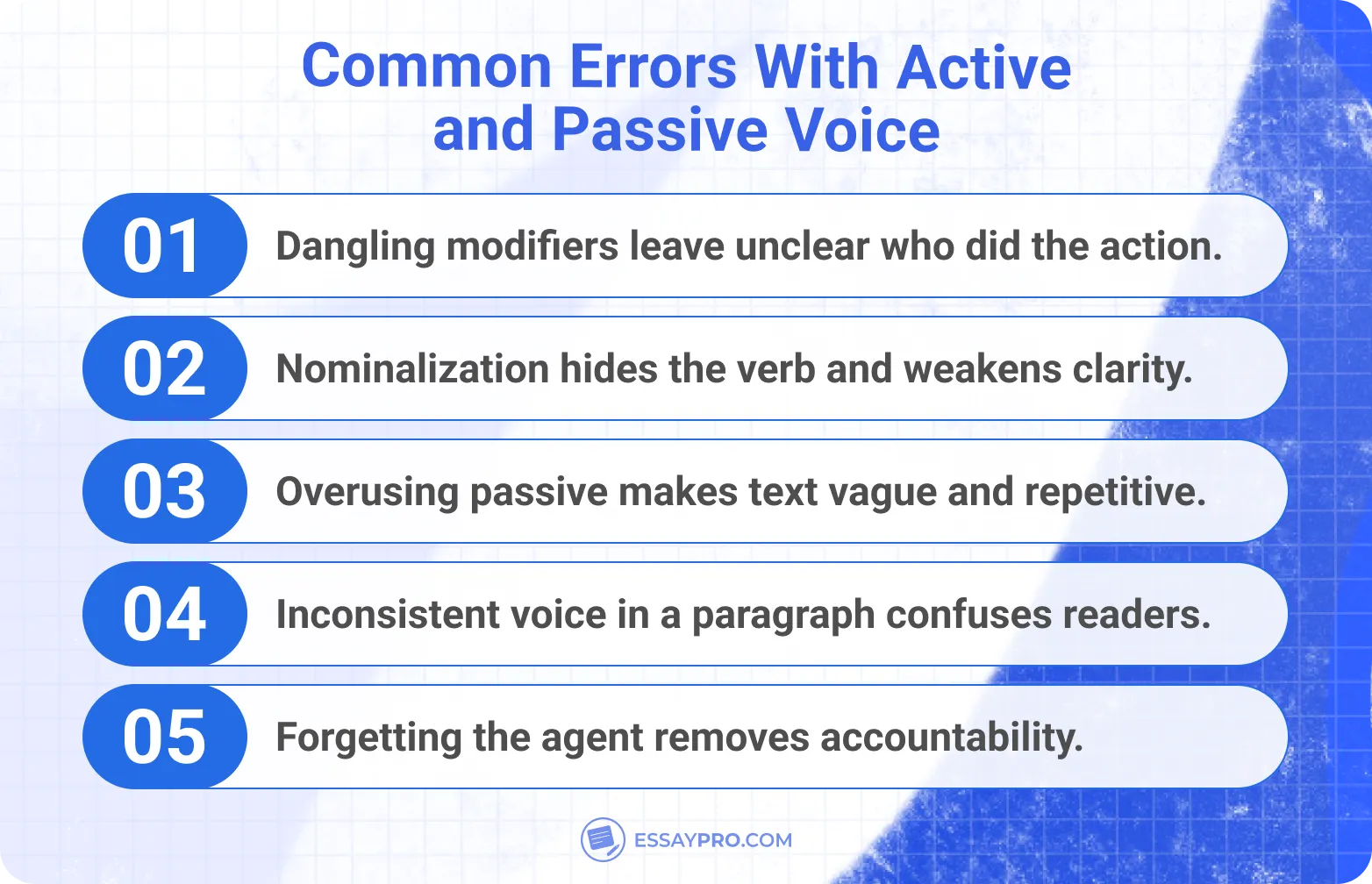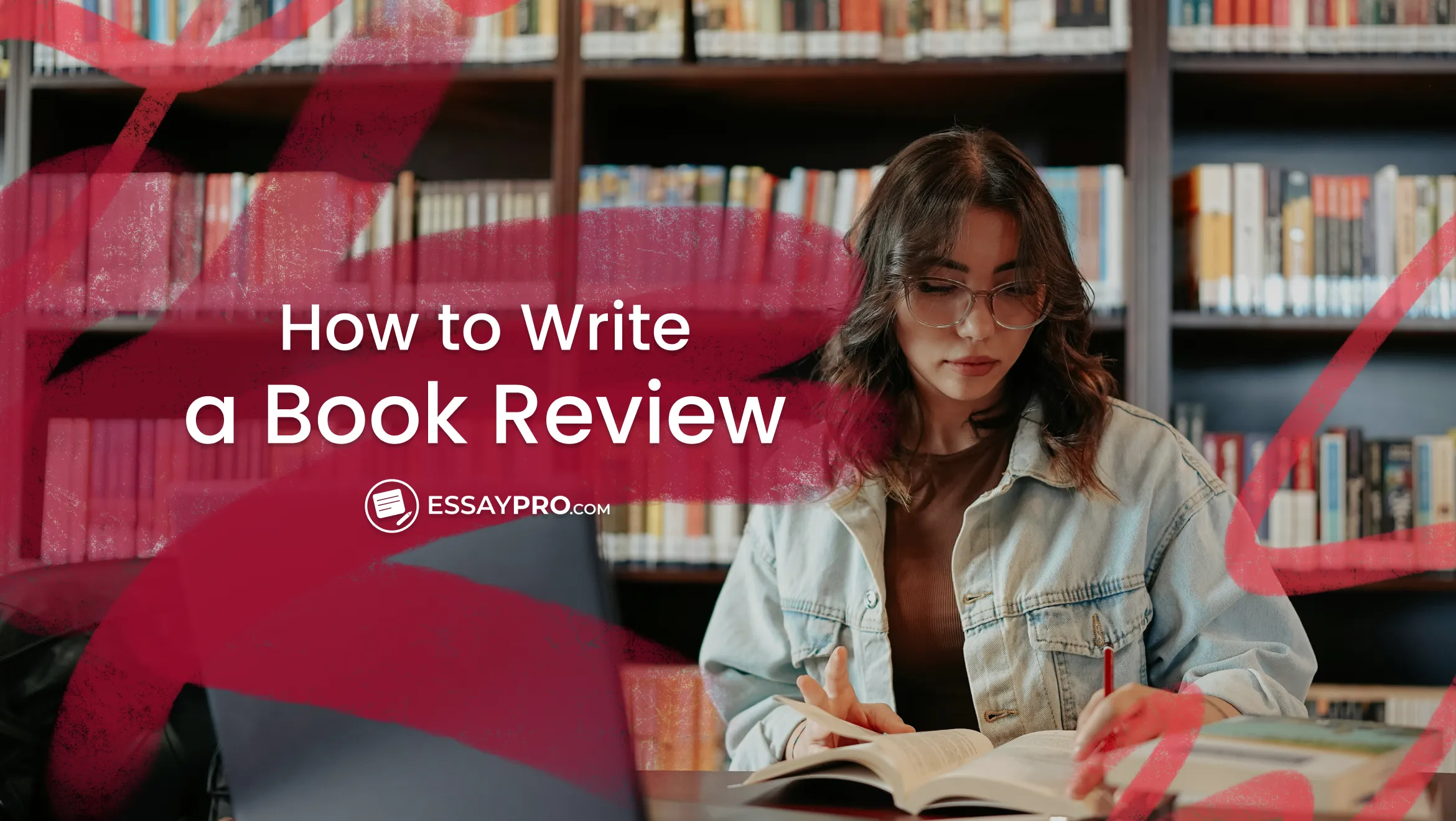Students often struggle with vague feedback like 'be clearer' or 'tighten your writing' without knowing what that really means. A common trigger is the debate over active and passive voice. Active voice names the subject up front and shows clearly who performed the action, while passive voice pulls the spotlight onto the object or result.
In this article, we’ll help you understand when to choose one over the other, giving you control over how claims are received and how evidence is weighed.
And whenever you find yourself stuck in writing, know that EssayPro has got your back. Our authors will help you avoid common pitfalls and make your paper shine.


What Is Active and Passive Voice?
Active voice is when the subject participates actively in the process of the action. Active voice makes sentences shorter, demonstrates agency, and keeps the reader focused on the subject, or who is doing what. In contrast, passive voice is when the object or outcome is presented first, and the subject is either absent or introduced later. The emphasis of a passive voice is more on the process or outcome of the action than the actor.
In academic writing, active and passive voice both serve a function: active voice works well for clearly stating a thesis or claim, while the latter is generally accepted in scientific writing to present results or methods.
Keep reading to see more of the active and passive voice definition with examples.
Writing in Active Voice
In the active voice, the subject comes first, the verb follows, and the object receives the action.
Active voice examples:
- People baked cookies.
- The dog chased the log.
- Researchers analyzed the data.
In ‘People baked cookies’, the subject (people) appears at the beginning. The verb (baked) shows the action. The object (cookies) receives that action. The grammar matches the mental picture: the actor, the act, the target.
Active sentences are almost always shorter because they avoid helper verbs like was or were. The active voice in academic writing maintains logical progression across sentences. When each sentence begins with the leading actor, the reader doesn’t need to reorient with every line. This ‘subject continuity’ reduces cognitive load, which is especially important in methods sections or literature reviews.
Writing in Passive Voice
To define passive voice, the object comes first, the verb is expanded with a form of be plus a past participle, and the subject is optional or placed later in a by-phrase.
A passive voice example could be:
- Cookies were baked by people.
- The log was chased by the dog.
- The data were analyzed by researchers.
In ‘Cookies were baked by people’, the object (cookies) now starts the sentence. The verb has changed from a simple past (baked) to were baked. The preposition by introduces the agent (people).
With passive voice in academic writing, several things change. Active verbs become heavier with auxiliary forms (was baked, were analyzed), the old object becomes the new subject, and the center actor becomes the process or product. This change can be useful in scientific writing where the method or finding is the real subject.
What’s the Difference Between Active and Passive Voice?
The main difference between active and passive voice meaning is that in the active voice, the subject performs the action, while in the passive voice, the subject receives the action.
Another difference worth mentioning is how each voice influences the thing you want the reader to notice first. For example, in ‘Researchers measured the results’, the subject, researchers, comes first, the verb, measured, follows, and the object, results, comes last. If you turn this sentence into a passive voice, you’ll get ‘The results were measured by researchers.’ Here, the results take center stage, and the people move to the end.
Should You Write in Active or Passive Voice?
There’s no simple answer to the question ‘Is active or passive voice better?’. You need both. You need to know the difference between the two: If you want your writing to sound direct, using active voice is smart; if you need to highlight results and keep the tone objective, go with passive voice.
Use Active Voice
Use active voice in academic writing when:
- You’re making a strong claim and need the reader to see accountability.
- You’re walking the reader through steps in an argument or process.
- You’re writing persuasively and want the sentences to sound firm, not vague.
Example (Active): Researchers tested the hypothesis.
Here, the subject (researchers) comes first, the verb (tested) shows the action, and the object (hypothesis) makes the sentence complete.
Active voice also helps cut down on wordy phrases. Compare ‘The hypothesis was tested by researchers’ with ‘Researchers tested the hypothesis’. The active version is cleaner and wastes no space.
Use Passive Voice
Situations where passive voice words work best include:
- The doer isn’t known or doesn’t matter: The artifact was dated to 500 CE.
- The focus is on the result: The hypothesis was tested.
- You want a formal, detached tone in lab reports or research papers.
- Historical writing, where the actor is obvious: The treaty was signed in 1945.
- Avoiding repetition when the same subject keeps showing up: Samples were collected. Samples were analyzed. Samples were stored.
Example (Passive): The hypothesis was tested.
The actor is hidden, but the result takes center stage. This framing works when readers care about the finding, not the people behind it. Passive voice keeps the spotlight steady in long procedures. Instead of switching subjects constantly, you keep the object, say samples or data, as the consistent thread across paragraphs.
While you’re here, take a look at our picks for top musical theater colleges if you’re planning to build a career in performing arts.
How to Turn Passive Sentences into Active Sentences
Making a sentence active as a passive means putting the doer back first in the sentence. Here, we can see active voice and passive voice, and how to change passive writing to active voice.
Learning to see this shift in focus takes practice. One way is to study finished work that shows how writers balance clarity with tone. Looking through process essay examples can help because they show step-by-step reasoning in action.
Active vs Passive Voice Examples
You probably wonder when it feels more natural to use either voice. We’ll give you five examples to show you how each voice is used in practice.
- Medical Case Report (Passive Voice)
- Passive: 'The patient was monitored for 48 hours after treatment.'
- Keeps the attention on the procedure and the outcome rather than the person performing it.
- Business Proposal (Active Voice)
- Active: 'Our team secured three new partnerships this year.'
- Makes the achievement clear and shows exactly who is responsible for it.
- History Paper (Passive Voice)
- Passive: 'The city was rebuilt after the earthquake in 1908.'
- Centers the event and result, leaving the individuals in the background.
- Policy Memo (Active Voice)
- Active: 'The department proposes new safety regulations for factories.'
- Directly connects the recommendation to the decision-makers.
- Instruction Manual (Passive Voice)
- Passive: 'The device should be stored in a dry environment.'
- Gives neutral, universal guidance without pointing to the user.
Common Patterns of Error
Errors in voice reveal how the writer is thinking about clarity and style.

- Dangling modifiers appear when a writer goes to passive voice without realizing the subject doesn't correspond to the phrase.
- Nominalization weakens text because it hides the verb.
- Overusing passive voice creates the illusion of objectivity while stripping away meaning.
- Inconsistent voice within a paragraph confuses the reader. Switching mid-stream forces readers to keep recalibrating their mental map.
- Using passive to 'sound academic' backfires. A sentence like 'It is believed that progress will occur' feels hollow.
- Forgetting the agent erases responsibility.
If managing all these details feels daunting, remember you don’t have to figure it out alone. Our management assignment help can always support you in structuring your projects!
Wrapping It Up
The real question is: What do you want the reader to see first: the doer, or the outcome? Active voice tightens arguments, names agents, and keeps claims accountable. Passive voice shifts attention to methods, results, or events that matter more than the actors. Both are essential in academic writing, but only when chosen deliberately. Students often default to passive voice because they think it 'sounds formal.' In reality, overuse makes text sluggish and unconvincing.
If balancing those choices feels difficult, EssayPro can help! You can also use our free essay plagiarism checker to make sure your writing is always clean before submitting.
FAQs
Which Voice To Use In Academic Writing?
Most instructors push for the active voice because it shows who did the work. However, in practice, academic writing needs both. Use active when you’re making claims and interpreting evidence. Use passive voice when methods, processes, or outcomes are more important than the researcher.
What Is The Active And Passive Voice In An Essay?
The active voice: the subject acts ('The student wrote the essay'). The passive voice: the subject receives the action ('The essay was written by the student').
What Is The Rule For Active And Passive Voice?
The active voice follows the subject, verb, and object. The passive voice flips this by moving the object to the front, adding a form of be plus the past participle, and sometimes tacking on the subject at the end with by.

Mariam Navrozashvili
She has a Master’s degree in English Literature and brings a deep understanding of storytelling, critical analysis, and language structure to her work. On EssayPro Blog Mariam writes guides on literary analysis, essay composition and language studies to help students improve their writing skills. In her free time she likes to read classic novels and discuss literary theory.
- Methodist College of Engineering and Technology. (n.d.). Active and passive voice. https://methodist.edu.in/web/uploads/files/Active-and-passive-voice.pdf
- McKendree University Writing Center. (n.d.). Passive verbs. https://www.mckendree.edu/offices/writing-center/resources/grammar/passive-verbs/
- Montana State University Writing Center. (n.d.). Active and passive voice. https://www.montana.edu/writingcenter/writing_resources/active-and-passive-voice.html








